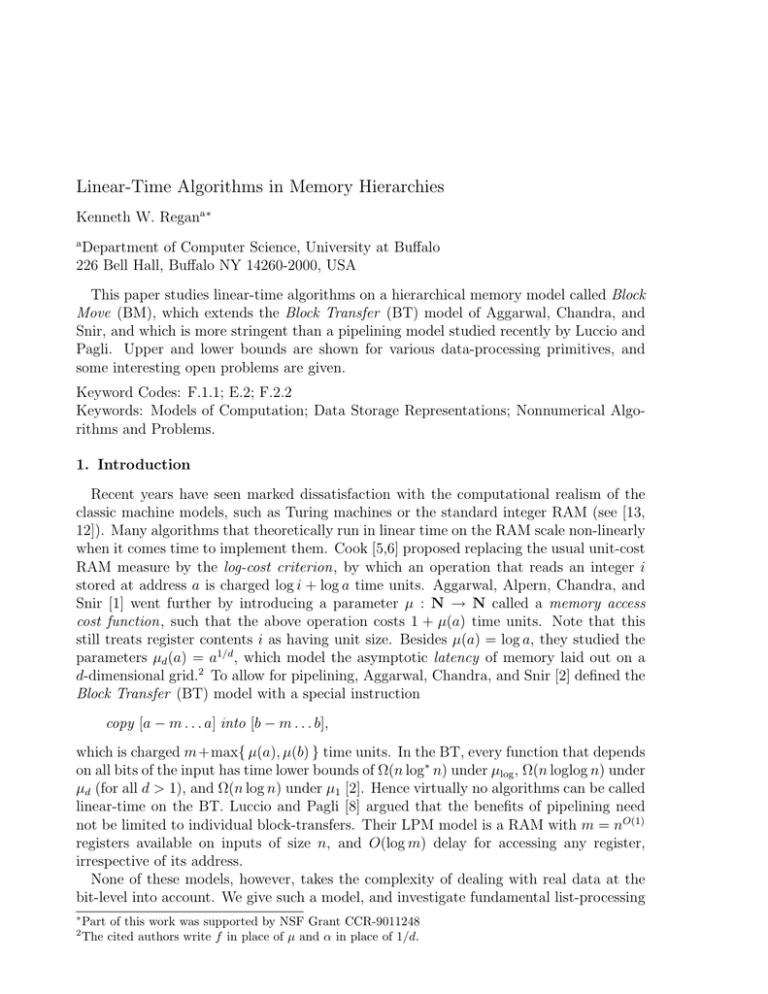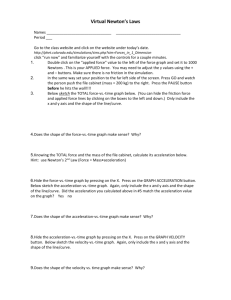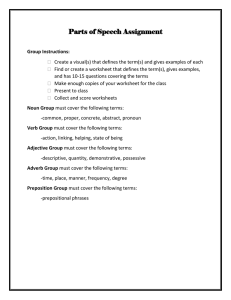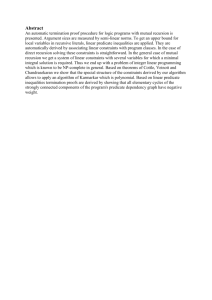Linear-Time Algorithms in Memory Hierarchies
advertisement

Linear-Time Algorithms in Memory Hierarchies
Kenneth W. Regana∗
a
Department of Computer Science, University at Buffalo
226 Bell Hall, Buffalo NY 14260-2000, USA
This paper studies linear-time algorithms on a hierarchical memory model called Block
Move (BM), which extends the Block Transfer (BT) model of Aggarwal, Chandra, and
Snir, and which is more stringent than a pipelining model studied recently by Luccio and
Pagli. Upper and lower bounds are shown for various data-processing primitives, and
some interesting open problems are given.
Keyword Codes: F.1.1; E.2; F.2.2
Keywords: Models of Computation; Data Storage Representations; Nonnumerical Algorithms and Problems.
1. Introduction
Recent years have seen marked dissatisfaction with the computational realism of the
classic machine models, such as Turing machines or the standard integer RAM (see [13,
12]). Many algorithms that theoretically run in linear time on the RAM scale non-linearly
when it comes time to implement them. Cook [5,6] proposed replacing the usual unit-cost
RAM measure by the log-cost criterion, by which an operation that reads an integer i
stored at address a is charged log i + log a time units. Aggarwal, Alpern, Chandra, and
Snir [1] went further by introducing a parameter µ : N → N called a memory access
cost function, such that the above operation costs 1 + µ(a) time units. Note that this
still treats register contents i as having unit size. Besides µ(a) = log a, they studied the
parameters µd (a) = a1/d , which model the asymptotic latency of memory laid out on a
d-dimensional grid.2 To allow for pipelining, Aggarwal, Chandra, and Snir [2] defined the
Block Transfer (BT) model with a special instruction
copy [a − m . . . a] into [b − m . . . b],
which is charged m+max{ µ(a), µ(b) } time units. In the BT, every function that depends
on all bits of the input has time lower bounds of Ω(n log∗ n) under µlog , Ω(n loglog n) under
µd (for all d > 1), and Ω(n log n) under µ1 [2]. Hence virtually no algorithms can be called
linear-time on the BT. Luccio and Pagli [8] argued that the benefits of pipelining need
not be limited to individual block-transfers. Their LPM model is a RAM with m = nO(1)
registers available on inputs of size n, and O(log m) delay for accessing any register,
irrespective of its address.
None of these models, however, takes the complexity of dealing with real data at the
bit-level into account. We give such a model, and investigate fundamental list-processing
∗
2
Part of this work was supported by NSF Grant CCR-9011248
The cited authors write f in place of µ and α in place of 1/d.
operations at the bit level, under the memory access cost functions µd . Then we give a
Kolmogorov-complexity technique that may impact on what Aggarwal and Vitter [3] call
the “challenging open problem” of extending the lower-bound results of theirs and other
papers to models that “allow arbitrary bit-manipulations and dissections of records.”
2. The Block Move (BM) Model
The BM makes three important changes to the BT. First, units of data are characters
rather than integers, and are held in numbered cells on a single tape. Second, any finite
transduction S, not just copy, can be applied to the data stream in a block move
S [a1 . . . b1 ] into [a2 . . . b2 ].
Formally S is a deterministic generalized sequential machine (DGSM), as defined in [7].
If z is the string formed by the characters in cells a1 . . . b1 , then S(z) is written into the
block a2 . . . b2 beginning at a2 . The validity condition for the move is that the intervals
[a1 . . . b1 ] and [a2 . . . b2 ] be disjoint, and the strict boundary condition is that the output
neither overflows nor underflows [a2 . . . b2 ], i.e., |S(z)| = |b2 − a2 | + 1. Third, the BM
provides shuffle and reversal operations, the latter by allowing b1 < a1 and/or b2 < a2
in block moves. Perfect bit-shuffle is implemented by allowing the blank B to be a
writable character in block moves, with the proviso that every B appearing in the output
stream S(z) leaves the previous content of its target cell unchanged. Under a given cost
function µ, the charge for a block move is m + µ(c), where m = |z| = |b1 − a1 | + 1, and
c = max{ a1 , b1 , a2 , b2 }.
Several particular machine forms of the BM are given in [10,11]. As shown in [11], the
BM is very robust: Under any µd function (d ≥ 1 and rational), these forms all simulate
each other up to linear time, not just polynomial time. Even machines allowed to violate
the validity and strict-boundary conditions are simulated with constant-factor overhead
by machines that observe them. Thus the complexity classes Dµd TIME[t(n)] of functions
computed in time O(t(n)) under µd are the same for all these forms. Hence we may
describe BM algorithms without reference to machine-specific details. Other main points
of distinction for the BM are that in contrast to the BT, many interesting functions are
computable in linear time, even under the highest cost function µ1 (a) = a. The BM under
µd is more realistically constrained than the LPM under log-cost; it compromises between
fixing the size of linear blocks as in [3] and having unrestricted pipelining as in [8].
3. Fundamental List Operations
Non-negative integers are encoded over Σ = { 0, 1 } in standard dyadic notation, with
the least significant bit first (“leftmost”). Lists whose elements are nonempty 0-1 strings
are encoded using boundary markers #. In order not to obscure the main ideas, we
abstract away the issue of space taken by these markers by extending Σ to an alphabet Γ
that includes the characters 0# and 1# . Γ also includes a special “padding character” @
and its compound with #, plus a primed “alias” c0 for each of the foregoing characters c.
Definition 3.1. A list is normal if its elements all have the same length m. A list is
balanced there exists j ≥ 0 such that for all i, 1 ≤ i ≤ n, 2j−1 < |xi | ≤ 2j . To normalize
a list means to pad each of its elements out to the same length m, while to rectify the list
means to pad each element out to length the next power of 2.
To illustrate timing considerations on the BM, consider the operation member (w, ~x ).
Comparing w separately with each member of ~x would incur access charges for each
element addressed, and the sum total of these under µd could approach n1+1/d . Copying
chunks of ~x into low-numbered cells (“cache memory”) is better, but would still not run
in linear µd -time if ~x has many small elements. If, however, the list ~x is normal and
|w| = m, a standard “recursive doubling” idea can be applied: First generate w#w#,
w#w#w#w#, etc. in successive passes until the w-list is at least as long as ~x. Then
shuffle the two lists character-wise, and do all the comparisons in a single sweep by a
DGSM. This runs in linear time even under µ1 (with the drawback is using linear auxiliary
memory). But what to do is ~x is not normal? Normalizing an unbalanced list can nearly
square the total bit-length n, but rectifying a list, or normalizing a balanced list, at most
doubles the length, and we have:
Proposition 3.1 A list can be rectified, and a balanced list normalized, in linear µ1 -time
and O(logn) block moves.
Proof. Suppose first that ~x is balanced. Let m0 := 2j from the definition of “balanced,”
and let n0 := rm0 , which will be the length of the output list. In a single pass over ~x,
a BM M can produce the list ~xe whose ith element is xei if |xi | is even, and xei @ if |xi |
is odd. M places ~xe into cells n0 /2...n0 − 1 of a special “holding track,” with underflows
permitted. A second pass computes the list ~xo of odd bits of elements. M writes ~xo onto
the main track and recurses on it, writing the “even pieces” to the holding track. The
invariants on the downward recursion are that at each level ~xo is balanced, and for each
i, 1 ≤ i ≤ r, the ith element of the even piece has the same length as the ith element of
the odd piece. The downward recursion stops when each element of ~xo has length 1.
The upward recursion maintains the invariant that the number k of marked characters
in each element yi makes |yi | + k a power of 2. At each upward step, M shuffles the
leftmost unused piece ~xe with ~y . Corresponding elements have the same number of bits
owing to the downward invariant. A single right-to-left pass by a DGSM with two states
s, t then makes the following transformations on pairs of bits (first bit from ~xe ):
s(c, d) →
7
(c, d)s s(@, d) 7→ (d0 )s s(c, d0 ) 7→ (c0 , d0 )s s(@, d0 ) 7→ (d0 )t
t(c, d) →
7
(c0 , d0 )s t(c, d0 ) 7→ (c0 , d0 )t.
The DGSM is always in state s when it reaches the end of one pair of list elements and
encounters a pair (c# , d# ) or (@, d# ) or (c# , d0# ) or (@, d0# ) that marks the boundary of
the next element. These are translated analogously as above. At the end of the upward
recursion the original list is reconstituted with the correct number of trailing symbols in
each element primed.
Finally, one more pass inserts the padding by translating primed characters c0 to c@.
The recursion for an unbalanced list is similar, except that extra markers are used to
indicate when a short element’s length has been cut to 1.
The padding characters are inserted into the middle, so that e.g. 10100 becomes
101@0@0@. Since all elements of equal length are padded the same way, and since all xi
with blog2 |xi |c =
6 blog2 |w|c can be marked for erasure during the recursion, this is good
enough for
Corollary 3.2 All occurrences of a given string w in a given list ~x can be found and
marked in linear µ1 -time and O(log n) passes.
However, to pad elements in front or in back, a further trick seems needed. The shuffle
of two r-element lists ~x and ~y equals x1 #y1 #x2 #y2 # . . . #xr #yr #.
Proposition 3.3 Within the same asymptotic time bounds, the padding in Proposition
3.1 can be made leading or trailing in each list element.
Proof. Lemma 6.1(b) of [11] shows how two normal lists can be shuffled in constant-many
passes. (The idea is to make spare copies of both lists, overwrite the even elements of
one copy and odd elements of the other by @ symbols, triple each @ symbol in one pass,
and then overlay the four lists.) Then shuffle the output of Proposition 3.1 with a copy
of itself, and in each successive pair of items, mark the padding in one and the original
of the other for erasure. This marking can be done in one pass by a DGSM that keeps
track of parity, and the added work is linear.
Binary addition and comparison can be done on the fly by DGSMs after shuffling
arguments bitwise. The methods in all these results combine to implement the standard
algorithm for parallel prefix sums, even making room for element growth due to carries.
Theorem 3.4 Prefix-sum, prefix-maximum, and other “census” ([8]) operations on lists,
can be computed in linear µ1 -time and O(log n) passes.
Moreover, there is a straightforward extension to segmented prefix-sum and other “scan”
operations. By results of Blelloch [4] on expressing many other operations in terms of
prefix-sum and prefix-max, this is enough to prove that the BM efficiently simulates his
integer-based scan model, except that each scan operation takes O(log n) block moves.
Consider normal lists ~x and ~y of size n = rm whose elements are sorted. Define the lists
to have small elements if m = O(log n), and large elements if for some > 0, m = Ω(n ).
Theorem 3.5 Under any cost function µd with d > 1, the problem of merging two lists
with large elements can be solved in linear µd -time.
Proof. Consider first the case m = r = n1/2 . Then the obvious merge by piecemeal
P 1/2
comparisons runs in linear time under µ2 , basically because ni=1 (in1/2 )1/2 = O(n).
If now m = n1/4 and r = n3/4 , the simple method takes µ2 -time n5/4 . However, “two
levels” of this method makes the time once-again linear: Mark the lists at every interval
1/2
1/2
of n0 = n1/2 bits. Then each chunk has n0 elements, each of size n0 . The simple merge
of the first chunks takes O(n0 ) time under µ2 . The first half of the merge of these two
chunks is a correct initial segment of the final merged list, and is copied to a separate
portion of memory, thus making room in the “cache” for a new chunk. The next chunk
of n0 bits (from whichever list was exhausted first in the previous step) is copied into the
cache in one block move, and the process repeated. The previous analysis now applies to
the time under µ2 to bring down the chunks, and the overall time is linear.
With m = n1/8 , extending the above recursion to three levels gives linear time under
µ2 . Working under higher cost functions µd with 1 < d < 2 has a similar effect to scaling
down the element size. That is enough for the proof.
Corollary 3.6 Sorting lists with large elements on the BM takes the same time under µd
with d > 1 as the best sequential algorithms do under unit cost.
This leaves two interesting problems: (1) Can lists with large elements be merged in linear
µ1 -time? (2) Can lists with small elements be merged in linear µd -time, for any d ≥ 1?
The results on sorting in [2] suggest a negative answer to (2) for all d, but disallow bit
operations on data in block transfers. The next section tries to extend their work.
4. Nonlinear Lower Bounds
We consider the problem of changing a given binary string x into a string y of the same
length n. Given a cost function µ and a fixed set S of DGSMs available to a BM program,
define Eµ (x, y) to be the least t such that some sequence of block moves (with DGSMs in
S) changes x to y in total µ-time t. We always suppose S contains copy and the single-cell
operations S0 , S1 which write 0 or 1. Also define eµ (n) := max{ Eµ (x, y) : |x| = |y| = n },
and write ed (n) as short for eµd (n) (d ≥ 1). In particular with x = 0n , Eµ (0n , y) is a
notion of description complexity for y, and we can fix x = 0n in defining eµ (n).
Theorem 4.1 For any fixed set S of block-move operations, e1 (n) = Θ(n log n), and for
all d > 1, ed (n) = Θ(n loglog n).
Proof Sketch. The upper bounds follow as in [2], and need only S0 , S1 , and copy. The
lower bounds intuitively hold because an operation with max address a can be specified in
O(log a) bits, but is charged µ(a) log a time. (Since there is no disparity for µ = µlog ,
no matching lower bound of Ω(n log∗ n), analogous to that in [2], is given for µlog .)
Details of the lower bound for d = 1: Given y, let P be a straight-line program such
that P (0n ) outputs y, and let ng(n) be the µ1 -time for this. Note that P itself is a
description of y. We will modify P into a short(er) description P 00 . For each i, 1 ≤ i ≤ k,
call the tape interval [2i−1 . . . 2i − 1] “region i.” Cell 0 is also part of region 1, while cells
2k onward also count as being in region k. Say that a block move is “charged in region i”
if its max address a is in region i. At only a constant-factor cost, we may round charges
in region i up to 2i , and add “dummy moves” to create P 0 such that every move by P 0
charged in some region i is followed by a move charged in region i − 1, i, or i + 1. Now for
each i, 1 ≤ i ≤ k, define N (i) to be the number of steps in P 0 charged in region i. There
must exist some i such that 2i N (i) ≤ ng(n)/k. Choose the greatest such i.
Then N (i) ≤ ng(n)/2i log n, and also for each j > i, N (j) > 2k−j g(n)/k. The moves
charged in regions j > i consume µ1 -time at least (k − i)2k g(n)/k. Since n = 2k , the total
µ1 -time available for all other moves is at most ng(n)(1 − (k − i)/k) = ng(n)i/ log n. By
the “adjacency” condition imposed on P 0 , all the moves charged in regions i and above
fall into at most N (i) high segments of the program P 0 . For each high segment, let P 00
give: (1) the contents of cells [0 . . . 2i−1 ] prior to the first move of the segment, and (2) the
instructions executed by P in that segment. Finally, after the last high segment, append
the first 2i−1 bits of y. This finishes P 00 . Elementary calculation then bounds the length
g(n)
g(n)
[n + C1 i2k−i + C2 i2 2k−i ] = log
Θ(n), where C1
of a straightforward encoding of P 00 by log
n
n
n
and C2 depend on kSk. Since there exist (many) strings y ∈ Σ such that the conditional
Kolmogorov complexity K(y|0n ) is ≥ n, it follows that g(n) must be Ω(log n).
Corollary 4.2 (compare [2,3]) There exist permutations of small-element lists that
cannot be realized in linear µd -time, for any d.
Proof. Let N = n log n be the bit-length of the list. Since there are n! = 2Θ(n log n)
permutations, some have Kolmogorov complexity Θ(N ). The above proof, with input 0n
replaced by the list 1#2# . . . #n, shows that every straight-line BM program computing
such a permutation requires time Θ(N log N ) under µ1 , and Θ(N loglog N ) under µd .
We suspect, eyeing the time-space tradeoff arguments of Mansour, Nisan, and Tiwari
[9], that this should lead to non-linear lower bounds on µd -time for natural functions such
as sorting, string convolutions, FFTs, and universal hashing. This may impact on their
conjecture that these functions require non-linear time on a Turing machine. We also ask
for lower bounds on testing element distinctness or on taking the intersection of two lists.
REFERENCES
1. A. Aggarwal, B. Alpern, A. Chandra, and M. Snir. A model for hierarchical memory.
In Proc. 19th STOC, pages 305–314, 1987.
2. A. Aggarwal, A. Chandra, and M. Snir. Hierarchical memory with block transfer. In
Proc. 28th FOCS, pages 204–216, 1987.
3. A. Aggarwal and J. Vitter. The input-output complexity of sorting and related problems. Communications of the ACM, 31:1116–1127, 1988.
4. G. Blelloch. Vector Models for Data-Parallel Computing. MIT Press, 1990.
5. S. Cook. Linear time simulation of deterministic two-way pushdown automata. In
Proceedings, IFIP ’71, pages 75–80. North–Holland, 1971.
6. S. Cook and R. Reckhow. Time bounded random access machines. J. Comp. Sys.
Sci., 7:354–375, 1973.
7. J. Hopcroft and J. Ullman. Introduction to Automata Theory, Languages, and Computation. Addison–Wesley, Reading, MA, 1979.
8. F. Luccio and L. Pagli. A model of sequential computation with pipelined access to
memory. Math. Sys. Thy., 26:343–356, 1993.
9. Y. Mansour, N. Nisan, and P. Tiwari. The computational complexity of universal
hashing. Theor. Comp. Sci., 107:121–133, 1993.
10. K. Regan. Machine models and linear time complexity. SIGACT News, 24:5–15,
October 1993. Guest column, L. Hemachandra ed., “Compelxity Theory Column”.
11. K. Regan. Linear time and memory efficient computation, 1994. Revision of UB-CSTR 92-28, accepted to SIAM J. Comput.
12. P. van Emde Boas. Machine models and simulations. In J. Van Leeuwen, editor,
Handbook of Theoretical Computer Science, pages 1–66. Elsevier and MIT Press, 1990.
13. K. Wagner and G. Wechsung. Computational Complexity. D. Reidel, 1986.






